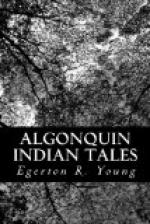“‘Come down, and have no fear,’ said Nanahboozhoo, in a friendly tone. ’I only want to give you this beautiful necklace to wear, with the white shell hanging from it.’
“On hearing this the kingfisher came down, but suspecting that Nanahboozhoo would be up to some of his tricks he kept a sharp watch on him. Nanahboozhoo placed the necklace about the neck of the bird so that the beautiful white shell should be over the breast. Then he pretended to tie the ends behind, but just as he had made a half knot in the cord, and was going to tighten it and strangle the bird, the latter was too quick for him and suddenly slipped away and escaped. He kept the necklace, however, and the white spot may be seen on the breast of the kingfisher to this day.
“Soon after this the shade or ghost of Nahpootee appeared to Nanahboozhoo and told him that, as his death was the result of his own carelessness, in not keeping on the land, he would not be restored to live here, but was even now on his way to the Happy Hunting Grounds, in the Land of the Setting Sun, beyond the Great Mountains.
“Nanahboozhoo was deeply moved by the loss of his brother, who had been such a pleasant companion to him. So great was his grief that at times the earth trembled and the evil spirits dwelling under the land or water were much terrified, for they knew they would be terribly punished by Nanahboozhoo if he should ever get them in his power. But it was a long time before he had an opportunity to get his revenge on them for the death of his brother. How he did it I will tell you at some future time.”
CHAPTER VII.
The Legend of the Bad Boy—How He was Carried Away by Annungitee, and How He was Rescued by His Mother.
“Tell us, Mary, a story about the boys of the old times among the Indians,” said Sagastao.
“About bad boys,” said Minnehaha with a mischievous look in her eyes; “for this morning brother and papa had to have a ‘settlement,’ and it might do Sagastao good to hear about other bad boys and what was done with them.”
These words of Minnehaha made Mary very angry. She thought more of Sagastao than she did of any other member of the family, and nothing threw her into a rage quicker than for anyone to cross him or even to question the wisdom of anything he said. Now, indignant that his father had been obliged to call him into his study for some misdemeanor, Mary was greatly annoyed to hear these words.
“O, pshaw, Sakehow,” said Sagastao; “do not be so touchy. I deserved the talking to that papa gave me. It was wrong of me to whack that Indian boy with my bat as I did, and I ought to have been punished; so if you have any jolly good stories about bad Indian boys, and how they were punished, why, let us have one.”
This confession of her favorite, who, after his temper cooled, was always quick to admit that he had been in the wrong, quite pacified Mary, and she settled down on the wolfskin rug with the children and began her story.




